
A Reprint from January 1996 , Vol. 19 No. 1
America's oldest and largest subjective-review audio
magazine. Subscription rates $33 (U.S. and Canada), and $75 US
(foreign). To Subscribe remit all funds to Stereophile,
469027, Escondido, CA 92046-9027, or call toll-free to charge
subscription to your credit card (800) 444-8908. Outside the US, call
(619) 745-2809.

Equipment Reports
DIVERGENT STRATEGIES
Wes Phillips examines the Alón Petite by Acarian Systems
|
Alón Petite by Acarian Systems: two-way, stand-mounted
loudspeaker with rear-firing port. Drive-units: 1" aluminum-alloy
dual-chamber dome tweeter, 5.25" tri-laminate cast-frame cone woofer.
Crossover frequency: 3.5kHz. Crossover slopes: damped second-order.
Frequency response: 55Hz - +20kHz, ±3dB. Sensitivity: 87dB/W/m
(2.83V). Nominal impedance: 8 ohms, 6 ohms minimum. Amplifier requirements: 50W.
Dimensions: 6½" W by 8¼" D by 15" H. Shipping weight: 30 lbs.
Serial numbers of review samples: 0113 / 0114. Prices: $995/pair
(walnut or black ash), $1195/pair (rosewood). Approximate number of
dealers: 65. Manufacturer: Acarian Systems Ltd., Hunters Run, Suite
104, 181 Smithtown Blvd., Nesconset, NY 11767. Tel: (516) 265-9577.
Fax: (516) 265-9560.
|
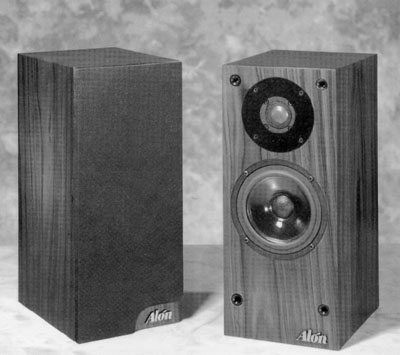 SLAM! My left foot went numb. My fellow
salesman, Danny Shapiro, had lost control of the Thiel CS5 that we'd
been walking into place in Demo Room V, and it had come crashing down
on my foot with unerring accuracy-- all 180 lbs worth.
SLAM! My left foot went numb. My fellow
salesman, Danny Shapiro, had lost control of the Thiel CS5 that we'd
been walking into place in Demo Room V, and it had come crashing down
on my foot with unerring accuracy-- all 180 lbs worth.
As I stared down in horror, I remembered that we'd left the spikes
on. But wait a minute-- there was no pool of blood spreading out
under the CS5. How could that be? Convinced that the heavy
cabinet was acting as a tourniquet, I levered it off my foot,
expecting a grisly sight. I got one: my new Rockport pierced by the
carpetpoint-- right between my big and second toes. And people ask me
why I like small loudspeakers.
There are other reasons. As JA pointed out in his review of the AE2
Signature and Platinum Audio Solo (Stereophile,, November 1995,
Vol. 18 No. 11, pp. 108-117), many rooms just can't support a speaker with
abundant LF information. Besides, the li'l guys frequently image
like bandits- which some of us just can't resist. There are also cost
constraints; not everyone can afford the $10k he-man jobbies. So it's
not surprising that there are a lot of small speakers on the market. What
does constantly astound me is the incredible variety of designs
offered in the realm of the two-way compact monitor. Good cases in
point are the two loudspeakers considered here; they illustrate just
what a broad diversity is available in design philosophy-- and also in
performance.
REVIEW CONTEXT
Both speakers were reviewed in my relatively small living room: 17'
by 10' by 8' high in the primary dimensions, although it's part of an
"open plan" living room/dining room/kitchen layout. I placed them
along the long wall which means I listened more or less near-field.
Both pairs benefited greatly from rigid, nonresonant stands-I used a
pair of Cliff Stone's 24" Foundation stands, which are filled with
aggregate and were spiked through the carpet to the concrete subfloor.
Although both loudspeaker pairs are quite efficient and can be driven
by modestly powered amplifiers, I used the Pass Aleph 0 monoblocks for
their wonderful transparency and unwavering image stability. The
preamp used was LAMM's Model Ll. At the front end were Theta's Data
Basic II/DS Pre Basic III and the Well Tempered Reference/SHO/Gold
Aero dB45 combos.
All of the components were plugged into two API Power Wedge 112s.
Interconnect was Kimber KCAG, speaker cable was Alón Black
Orpheus-- an extremely interesting design that has little bulk, even in
bi- and tri-wired runs. Both pairs of speakers were thoroughly run-in
before audition with burn-in tones, my Rykodisc A Day on Cape Cod:
Babbling Brook, and abundant quantities of music. Only one pair of
speakers was in the listening room during the auditions.
ALÓN PETITE: $995 / PAIR
Alón by Acarian Systems is certainly no newcomer to the High
End: for the last five years they've built an enviable track record,
producing one well-regarded full-range design after another. Carl
J. Marchisotto, Alón's President, engineer, and speaker
designer, has been designing audio gear since 1973, when he marketed a
solid-state phono section under the name Alltest. Later, he joined
Dahlquist, designing the DQLP-1 electronic crossover (still highly
regarded and sought-after on the used market) and improving the
DQ-10's basic design. The DQ-20 and DQ-12 also show his influence.
He still employs the open-baffle concept on most of the Alón
designs; Petite is the sole exception.
The Petites, introduced at Winter Consumer Electronics Show '95,
immediately attracted the attention of the industry. If you've read
about these speakers at all, you know they were "set up" by being
placed atop a clunky hotel chest-of-drawers, and were powered by a
modestly priced integrated amplifier-- and everyone still came away
raving. They're a small speaker (6 ½" W by 8 ¼" D by 15" H), vented
to the rear, and have two pairs of high-quality five-way binding
posts to facilitate bi-wiring. These are wonderful binding posts;
although they sport knurled cylindrical barrels, the last ¼" is
hexagonal, allowing you to tighten the connection with a hex-driver or
Postman wrench. The well-made cabinet gives a satisfyingly consistent
thunk to the knuckle-rap test. The review pair was veneered with
Santos Rosewood, lustrous and rich with a tight grain pattern.
Removable grilles are included-- and should be removed. All of my
audition was performed with grilles off.
Sonics: The Petites were placed relatively near the record shelving
that lines the long rear wall of my listening room. I employed David
Wilson's "voweling" process (see Stereophile, November '95, p.101)-- or something resembling it-- to locate the point where the speaker "freed up" from the rear wall's boundary effect. In my room, this was approximately 14" from the shelves. The speakers sounded best with a very slight toe-in; however, this may not be
true in situations where the listener sits at a greater distance from
the speakers. The Petites also benefit from being tilted back--
severely, in my case-- in the vertical plane: the front spikes were 2"
taller than the rear. Again, listeners must experiment with this type
of positioning based on the ratios particular to their own
situations-- I found the response to be much more coherent when the
Alóns were placed in this manner in my room.
These are remarkably refined performers. As I listened to my favorite
music-- and to a lot of new stuff-- I was consistently impressed with how
much musical enjoyment I could derive from a pair of "modestly priced"
loudspeakers. Of course, they're small and have limited LF-- that's what
compact monitors are. But given that restriction, I must
still marvel at the sense of weight that these li'l guys gave to music
that contained deep bass.1 In this regard they don't
rival the Thiel CS7s, or any other true mid-20Hz performer, but they
sure didn't sound anemic either. Orchestral works, such as my standby
Corigliano Symphony 1, were re-created with great elán, but did
inevitably lose some power. But the drive, the sense of doom and
foreboding, and the organic sense of pace that distinguish the work
survived intact. That's a lot of pluses, and it could be argued that
all of those qualities are ultimately more important to an informed
appreciation of the Symphony than the mere sensation of wallop. I
lean toward that interpretation myself, but I'm enough of an
audio-weenie to want it all, even at this price point.
The Corigliano also pointed toward another-- extremely minor, I
think-- shortcoming of the Petite: If pushed really hard-like, say, in
the range of 100dB-- they lose coherence. Sure, orchestras, big
bands, and rock groups do regularly reach sound-pressure levels
(spls) in that area, but remember, we're talking about speakers that
are designed for smaller spaces that might not accommodate deep bass.
All spaces can acoustically overload, even Carnegie Hall (I've heard
both the VO and the CSO manage that trick).
When really stressed, the Petite gets a tad blurry through a broad
midrange band, as though the drivers were no longer in perfect sync.
In fact, the brightness region seems to be projecting forward of the
rest of the soundstage. Cymbals and string overtones sound spitchy,
and the midbass, normally so expressive, turns opaque. There's a
simple solution for this: turn the music down! Or, perhaps, add the
subwoofer that Alón has just introduced.
I wanted to get those extremely minor cavils out of the way so that
I could concentrate on describing these compact speakers' many
admirable traits. They're extraordinarily expressive. Not just
articulate and precise-- which they are, in spades-- but sublimely
capable of communicating. This is a rare feature; many megabuck
no-holds-barred components don't possess it, so I'm particularly gratified
to find it in affordable ones.
I'm an old softie at heart; I seem to listen to a lot of music about
loss and longing. Listening through the Petites, I found myself
surreptitiously wiping away tears while writing my listening notes.
"Goodbye," from Steve Earle's Train a Comin' (Winter Harvest 3302-2), is
a good case in point. Earle's voice was never a supple instrument to
begin with, and with the life he's led, he can't exactly be accused of
having pampered it; still, he gets the job done. The song is searingly
honest; the singer is looking back on a lost opportunity and accepting
responsibility for it. "Was I off somewhere just too high / But I
can't remember if we said goodbye," Earle sings-- heck, almost
croaks-- but the simple words are imbued with missed chances, rueful
responsibility, and deep, deep regret. An old friend claims that high
art is made out of the meanest materials; this song proves her
point-- and the Petites get it all so right.
And image? That's a lot of the appeal in minimonitors in the first
place, and the Petites are champs in that regard. Train a Comin'
really sounds like a coupla guys sittin' around your living room playing
and singing together. When Norman Blake plays his solo piece, "Northern
Winds," he's a solid and present as a guest in the room-- and there's no
doubt that he's playing his 1934 D-18. Each of the four musicians is concretely
placed in space, surrounded by air, and full of life and verve. Watch out!
Peter Rowan just bounced a pick off his F-5-- it could've hit you.
Palestrina's Missa Viri Galilaei, as performed by La Chapelle
Royale and Ensemble Organum (HMC 901388), seems to always find its way
to my CD player when I'm evaluating a system's ability to soundstage.
It's a truly nasty test, featuring a vast acoustic and combinations of
singers that range from solo to duet to quartet, quintet, and full
chorus-- with dialogs between the solo (and small-group voicings) and
the chorus. Colorations are revealed mercilessly, as is any loss of
ambient information. The Petites did a fantastic job of portraying the
vocal combinations in the reverberant acoustic, doubly impressive when
you consider how much ambient information is contained in the lowest
octaves. The soloists and choirs had great physical presence, and the
passion with which they sang was rendered with exceptional force. Yet
the specific nature of the huge space in which they sang lost the
slightest bit of precision-- although the voices were clearly in a
large space, that space lacked the identity that it achieves through
the finest speakers I've recently auditioned: the WATT/Puppy 5s and
the Thiel CS7s.
But who am I kidding? You could buy fifteen pairs of
Petites for the price of the Wilsons, nine for the Thiels. The
Petites perform way out of their price class, and if I can
point to one state-of-the-art design or another and find the Alóns
lacking in comparison, there's no shame in that.
-Wes Phillips
Measurements from JA: As expected from its
diminutive proportions, the Petite is not very sensitive, 2.83V
raising a calculated 83dB at 1m (B-weighted). However, its impedance
traces (fig.1) reveal it as an easy load for an amplifier to drive,
dropping below 8 ohms only in the midrange. Though no wrinkles can be
seen in the impedance traces, the cabinet was generally lively in the
350-500Hz region. No strong individual resonant modes could be found,
however, which suggests an optimally constructed cabinet.
Fig. 2 shows the individual responses of the Acarian's drive-units on
the tweeter axis at a measuring distance of 50". (The lower reaches of
the woofer's output and the port response were measured in the
nearfield.) The crossover can be seen to lie around the specified
3.5kHz, though the woofer has a distinct step in its output just above
1kHz. The output of the tiny port is the bandpass centered on the
woofer's minimum-motion frequency, 52Hz, and I noticed considerable
chuffing and wind noise coming from it at even moderate levels when
the speaker was driven by a pure sinewave. Luckily, music will offer
some masking and the port does face the rear.
How these individual responses sum on the tweeter axis can be seen in
fig.3. The complex sum-- magnitude, phase, and distance-- of the woofer
and port low-frequency outputs rolls off gently below 100Hz, reaching
the 6dB-down point at a moderate 55Hz; not bad extension for such a
small speaker. Though the overall balance is smooth and even, the
step in the woofer's on-axis response remains a distinct feature.
This response shape is almost always associated with a pronounced
nasality to a speaker's sound, in my experience, so I was initially
puzzled as to why WP didn't notice any excessive coloration. Then I
read that he had to tilt the speaker backward quite a ways to get a
balance he liked. My choice of the tweeter axis was not optimal,
therefore. Fig.4 shows how the Petite's response changes as the
listener moves up or down from the tweeter axis. (Just the response
differences are shown in this graph; hence, the tweeter-axis response
appears to be a straight line.) As can be seen from fig. 4, the
speaker's output in the region just above the step increases by up to
5dB for listening angles more than 15° above or below the tweeter
axis. The response on WP's preferred axis is shown in fig.5-- though a
slight discontinuity can still be seen at 1kHz, the response is pretty
flat overall.
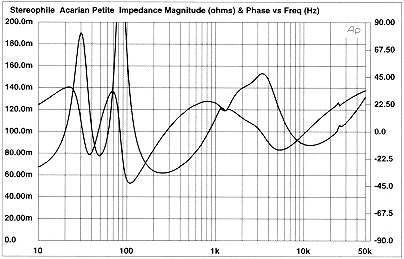
Fig.1 Alón Petite, electrical impedance (solid) and phase
(dashed) (2 ohms/vertical div.).
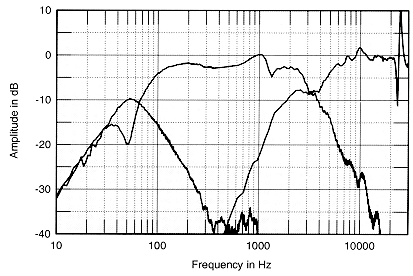
Fig.2 Alón Petite, acoustic crossover on tweeter axis at 50",
corrected for microphone response, with nearfield woofer and port
responses plotted below 300Hz and 1kHz, respectively.
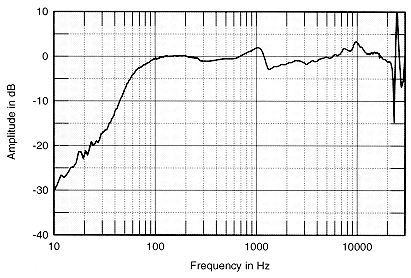
Fig.3 Alón Petite, anechoic response on tweeter axis at 50",
averaged across 30° horizontal window and corrected for microphone
response, with complex sum of nearfield woofer and port responses
plotted below 300Hz.
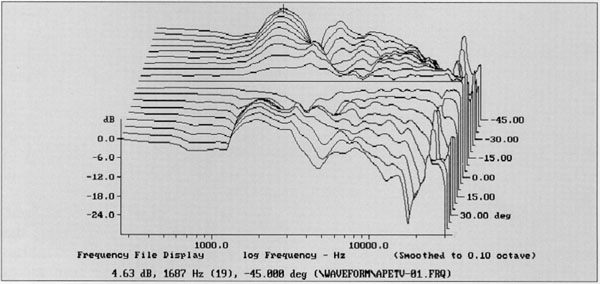
Fig.4 Alón Petite, vertical response family at 50", normalized
to response on tweeter axis, from back to front: differences in
response 45° - 5° above tweeter axis; reference response; differences
in response 5° - 45° below tweeter axis.

Fig.5 Alón Petite, anechoic response on optimal axis at 50",
corrected for microphone response, with complex sum of nearfield
woofer and port responses plotted below 300Hz.

Fig.6 Alón Petite, horizontal response family at 57",
normalized to response on tweeter axis, from back to front:
differences in response 90° - 5° off-axis on tweeter side of
baffle; reference response; differences in response 5° - 90°
off-axis on woofer side of baffle.
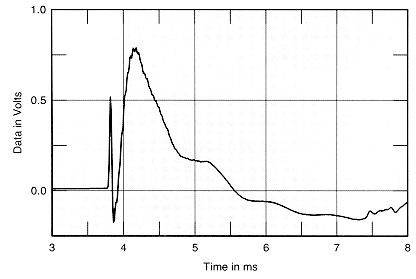
Fig.7 Alón Petite, step response on tweeter axis at 50" (5ms
time window, 30kHz bandwidth).

Fig.8 Alón Petite, cumulative spectral-decay plot at 57" (0.15 ms risetime).
WP also commented on the Petite's fine imaging. Fig.6 shows how the
speaker's sound changes to its sides. The textbook rolloff in the top
two octaves with increasing off-axis angle, coupled with an excellent
match between the woofer and tweeter dispersion patterns in the
crossover region to the sides, is always associated with excellent
stereo imaging, in my experience.
In the time domain, the step response (fig.7) reveals that both
drive-units are connected with the same positive acoustic polarity,
but as expected from the flat front baffle, the tweeter's output leads
the woofer's by a fraction of a millisecond. Other than the on-axis
step at 1khz, the Petite's cumulative spectral-decay or waterfall plot
(fig.8) is simply superb, clean and free from resonant problems.
All in all, the Petite is a well-engineered little speaker and,
provided care is taken over what axis the listener listens on, should
offer a neutral, well-balanced sound. -John Atkinson
Wes Phllips sums up:
Compared to other thousand-dollar
loudspeakers, the Petites are winners. There are a lot of
considerations in choosing a speaker in their very competitive
price-class. The Ruark Templar I reviewed in December, the Thiel .5
MK reviewed in November, and the Monitor Audio Studio 2 I reviewed
back in February are all worthy contenders. But I'd have to say
that, even given the caliber of the competition, the Alón
Petites would head any list I compiled of must-audition, affordable minimonitors. Let's just dub them "first among equals."
-Wes Phillips
1 Alón has recently introduced a novel stereo
single-box subwoofer to augment the Petites. Robert J. Reina will be
reviewing it in a few months.

MANUFACTURER'S COMMENTS
ACARIAN ALÓN PETITE
Editor:
Many thanks to Stereophile and Wes Phillips for this fine
review of the Alón Petite mini-monitor. Our goal in the Petite
project was to produce a small loudspeaker that did not sound
deficient in its ability to communicate the essential emotion and
intent of the music. While, as pointed out in the review, this is quite
difficult for any loudspeaker regardless of size or price, we feel it
is extremely rare in a small loudspeaker. That the Alón Petite
cornmunicated musical and emotional intent, even on large-scale works
such as the Corigliano Symphony 1, indicates that we have met our
goal.
Regarding the reproduction of large acoustic spaces, we can say that
this aspect is improved by the addition of the new PW1 Petite woofer,
which will extend response to 32Hz.
We recommend, as Wes pointed out, that for the most critical
listening, the Petites should be tilted back 9°. This can be
achieved by raising the front spikes 2" more than the rear. This
tiltback brings the high- and low-frequency responses into the same
time frame.
While the Alón Petite is intended to be a moderately priced
product, it is interesting to note that it causes comparison with
loudspeakers costing nine to fifteen times as much. We think Wes best
summed it up with his final comment: "first among equals."
Once again, thanks for this fine review.
CARL J. MARCHISOTTO, President
MARILYN MARCHISOTTO, Vice President
Acarian Systems


 SLAM! My left foot went numb. My fellow
salesman, Danny Shapiro, had lost control of the Thiel CS5 that we'd
been walking into place in Demo Room V, and it had come crashing down
on my foot with unerring accuracy-- all 180 lbs worth.
SLAM! My left foot went numb. My fellow
salesman, Danny Shapiro, had lost control of the Thiel CS5 that we'd
been walking into place in Demo Room V, and it had come crashing down
on my foot with unerring accuracy-- all 180 lbs worth.







